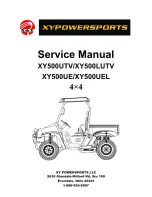
3-13
3
Servicing Top-Side
Components
NOTE: Whenever a part is worn excessively,
cracked, or damaged in any way, replacement is
necessary.
VALVE ASSEMBLY
When servicing valve assembly, inspect valve seats,
valve stems, valve faces, and valve stem ends for pits,
burn marks, or other signs of abnormal wear.
NOTE: Whenever a valve is out of tolerance, it
must be replaced.
Cleaning/Inspecting Valve Cover
NOTE: If the valve cover cannot be trued, the cyl-
inder head assembly must be replaced.
1. Wash the valve cover in parts-cleaning solvent.
2. Place the valve cover on the Surface Plate covered
with #400 grit wet-or-dry sandpaper. Using light
pressure, move the valve cover in a figure eight
motion. Inspect the sealing surface for any indica-
tion of high spots. A high spot can be noted by a
bright metallic finish. Correct any high spots
before assembly by continuing to move the valve
cover in a figure eight motion until a uniform
bright metallic finish is attained.
CC130D
Removing Valves
NOTE: Keep all valves and valve components as
a set. Note the original location of each valve set
for use during installation. Return each valve set to
its original location during installation.
1. Using a valve spring compressor, compress the
valve springs and remove the valve keepers.
Account for an upper spring retainer.
CC994
2. Remove the valve seal and the lower remaining
spring seat. Discard the valve seal.
CC134D
CC136D
NOTE: The valve seals must be replaced.
3. Remove the valve springs; then invert the cylinder
head and remove the valves.
CAUTION
Do not remove an excessive amount of the sealing
surface or damage to the camshaft will result. Always
check camshaft clearance when resurfacing the valve
cover.
CAUTION
Water or parts-cleaning solvent must be used in con-
junction with the wet-or-dry sandpaper or damage to
the sealing surface may result.
Next
Back
Section
Table of Contents
Manual
Table of Contents














































